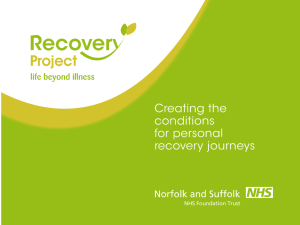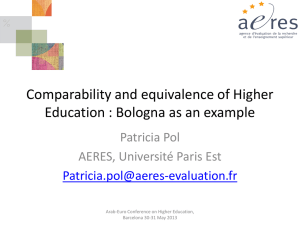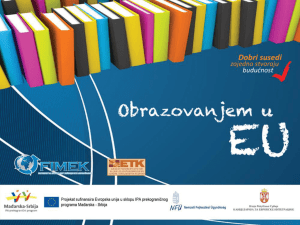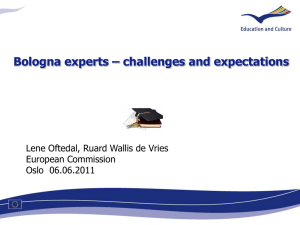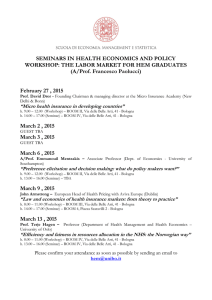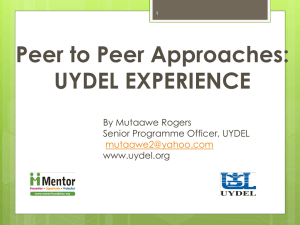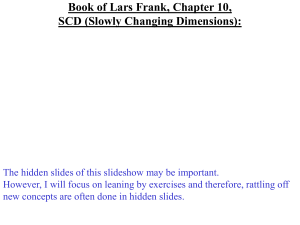The Social Dimension of the Bologna Process
advertisement
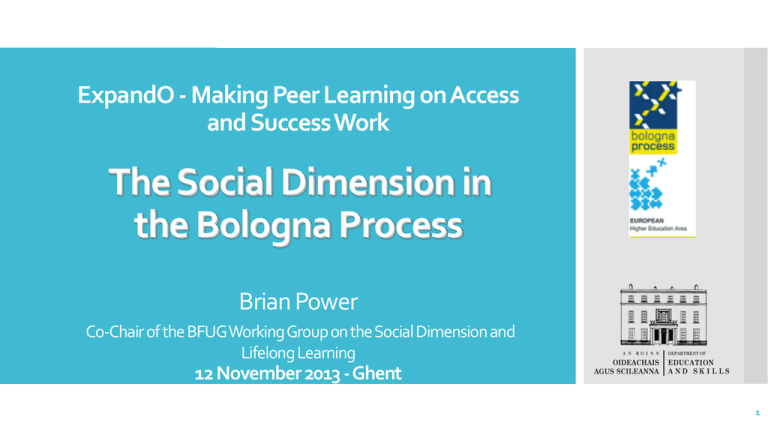
ExpandO - Making Peer Learning on Access and Success Work The Social Dimension in the Bologna Process Brian Power Co-Chair of the BFUG Working Group on the Social Dimension and Lifelong Learning 12 November 2013 -Ghent 1 The Bologna Process The Social Dimension – what do we mean? Overview What do we want to achieve? How do we go about achieving it? Peer Learning in the Bologna Process Intergovernmental Process 47 participating countries, European Commission and representatives of higher education institutions, students, staff, employers and quality assurance agencies The Bologna Process Purpose of the Bologna Process: Improve international transparency of programmes and the recognition of qualifications Convergence towards a common framework of qualifications and cycles of study Greater mobility of students and teachers In brief, a European Higher Education Area 3 Every second year, Ministers meet to measure progress and agree priorities for action The main follow-up structure is the Bologna Follow-up Group (BFUG) Bologna Structures Oversees the Bologna Process between the ministerial meetings Meets at least once every six months Supported by the Bologna Secretariat Sets up working groups to deal with specific topics in more detail 4 Berlin (2003), Ministers acknowledged that the need to increase competitiveness must be balanced with the objective of improving the social characteristics of the European Higher Education Area The Social Dimension One of the aims of the EHEA must be to strengthen social cohesion and reduce social and gender inequalities both at national and at European level London (2007), Ministers agreed on a definition of the social dimension: “…that the student body entering, participating in and completing higher education at all levels should reflect the diversity of our populations…” 5 Centre for Social Policy Studies of the University of Antwerp in 2009 2012 BFUG implementation report Collecting and comparing more detailed national level data on the social dimension presents real challenges Challenges Social dimension understood differently from one country to another National level policies not linked to the Bologna commitment Measurement and monitoring of target groups are not consistent across national boundaries 6 How do we ensure a coherent approach to ensuring equity of access across in our higher education systems? Key questions How do we support those working in the area of access in addressing this important policy objective? How do we ensure that what we learn and what demonstrably works is reflected in national and international policy and practice? 7 Critical both in economic and social terms to secure more equitable access to, participation in and completion of higher education Strong interdependence of social and economic objectives Key objectives Europe’s economic recovery is increasingly dependent on its capacity to develop the skills of all its citizens There are too many capable individuals who do not participate in higher education for social, cultural or economic reasons Measures to ensure equitable access, participation and completion 8 Critical to identify, measure and monitor participation of underrepresented groups Underrepresented groups in higher education Who is underrepresented? Lower socio-economic groups Students with disabilities Mature students National context is important Ethnic minorities Migrants Rural isolation 9 General Policy Approaches What approaches? Financial supports Flexible pathways RPL Student-centred teaching and learning for a more diverse student population Guidance and counselling Student services Targeted Policy Approaches Enhanced financial supports for target groups Alternative admission systems Targeted teaching and learning assistance Tailored guidance and counselling services Outreach services to specific groups and communities 10 Political commitment through ministerial agreement In the EU Council of Education Ministers In the Bologna ministerial meetings How do we move the agenda forward? Adoption of specific objectives and strategies at national level Institutional commitment to access and success Measuring, monitoring and analysis of impact Peer learning Sharing of experience and “what works” Analysing and contextualising National and international Irish Presidency of the EU 2013 – May Council of Education Ministers Council conclusions on the social dimension of higher education Political commitment to: EU Council Conclusions Adopt national objectives which are aimed at increasing the access, participation and completion rates of under-represented and disadvantaged groups in higher education, with a view to progressing towards the Bologna Process goal Systematic collection of relevant comparable data to enhance the evidence base for policy development and to enable the effective monitoring of national objectives on access, participation and completion Commission actions Pursue work on the social dimension through peer learning, engagement in the Open Method of Coordination and working within the Bologna Process Bucharest Communiqué “Widening access to higher education is a precondition for societal progress and economic development. We agree to adopt national measures for widening overall access to quality higher education.” “Strengthen policies of widening overall access and raising completion rates, including measures targeting the increased participation of underrepresented groups” “Develop a system of voluntary peer learning and reviewing by 2013 in countries which request it and initiate a pilot project to promote peer learning on the social dimension of higher education” 13 Working Group on the Social Dimension and LLL Two meetings per year – Chairs and sub-groups ongoing Objectives and work plan Thematic Strands: SD&LLL WG Access initiatives, guidelines for national access plans Teaching and Learning Student supports and services Lifelong Learning and Employability Social Dimension & LLL Strategy for the EHEA Development of the pilot project on peer learning for the social dimension - PL4SD 14 Peer Learning for the Social Dimension – or “PL4SD” Three-year project to 2015 funded by the EU Commission Provide research and analysis to support the development of social dimension policies in the EHEA PL4SD Structure information on national and institutional policies and initiatives and collect and analyse relevant reports and research Database of comparative information Both peer learning and peer review Three country reviews to be completed by end-2014 Outcomes for individual countries and for EHEA 15 ExpandO will provide extremely valuable lessons Important synergies – both social dimension and peer learning Peer learning as a method: ExpandO experience the challenges and how these were overcome difficulties that could not be overcome lessons to be drawn on approach to peer learning in the social dimension Comparative analysis of six systems examining policies, regulations and measures taken to improve access and success National action plans Recommendations on best practice in funding, monitoring, quality assessment and networking 16 Greater development of peer learning in both EU OMC and Bologna Process Move away from simple exchanges of best practice Greater emphasis on key data analysis to demonstrate impact Peer learning for peer learning? National, regional or institutional contexts may be critical to success of individual measures Peer learning and peer review ExpandO has been a pathfinder initiative, both in terms of peer learning and the social dimension Enormously valuable well of experience from which to draw Enduring legacy of learning and ongoing cooperation Thank you Brian Power Head of Student Support and Equity of Access to Higher Education Department of Education and Skills Ireland Brian_Power@education.gov.ie 18


